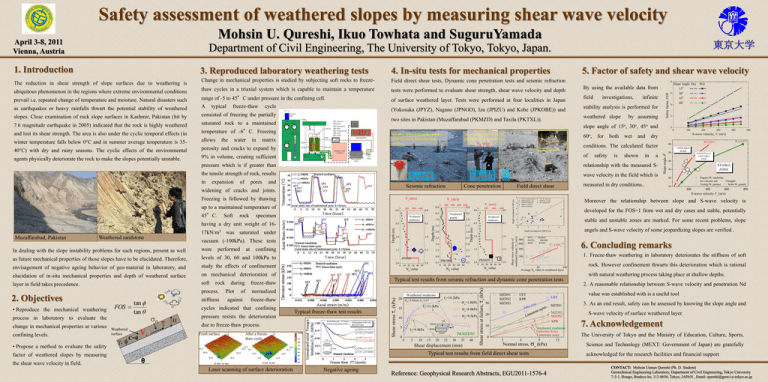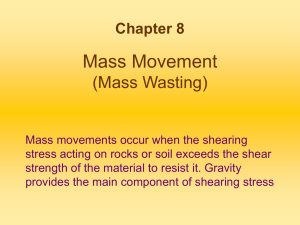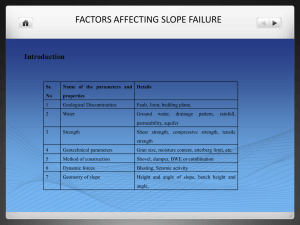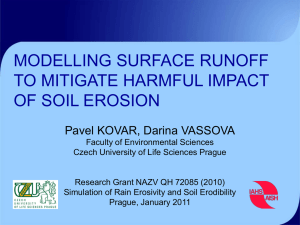Presentation - Copernicus.org
advertisement

Safety assessment of weathered slopes by measuring shear wave velocity Mohsin U. Qureshi, Ikuo Towhata and SuguruYamada April 3-8, 2011 Vienna, Austria 東京大学 Department of Civil Engineering, The University of Tokyo, Tokyo, Japan. Change in mechanical properties is studied by subjecting soft rocks to freeze- Field direct shear tests, Dynamic cone penetration tests and seismic refraction ubiquitous phenomenon in the regions where extreme environmental conditions thaw cycles in a triaxial system which is capable to maintain a temperature prevail i.e. repeated change of temperature and moisture. Natural disasters such as earthquakes or heavy rainfalls thwart the potential stability of weathered range of -5 to 45°C under pressure in the confining cell. A typical freeze-thaw cycle slopes. Close examination of rock slope surfaces in Kashmir, Pakistan (hit by consisted of freezing the partially 7.6 magnitude earthquake in 2005) indicated that the rock is highly weathered saturated rock to a maintained and lost its shear strength. The area is also under the cyclic temporal effects (in temperature of -6°C. Freezing winter temperature falls below 0°C and in summer average temperature is 35- allows the water in 40°C) with dry and rainy seasons. The cyclic effects of the environmental agents physically deteriorate the rock to make the slopes potentially unstable. 9% in volume, creating sufficient tests were performed to evaluate shear strength, shear wave velocity and depth of surface weathered layer. Tests were performed at four localities in Japan (Yokosuka (JPYZ), Nagano (JPNGO), Izu (JPIZU) and Kobe (JPKOBE)) and Seismic refraction analysis was done by using Intercept time method No. of drops for 10 cm of penetration is recorded as Nd value. and Seismic refraction widening of cracks and joints. at In dealing with the slope instability problems for such regions, present as well as future mechanical properties of those slopes have to be elucidated. Therefore, levels of 30, 60 and 100kPa to envisagement of negative ageing behavior of geo-material in laboratory, and elucidation of in-situ mechanical properties and depth of weathered surface on mechanical deterioration of layer in field takes precedence. soft 2. Objectives • Reproduce the mechanical weathering tan FOS tan process in laboratory to evaluate the change in mechanical properties at various confining levels. • Propose a method to evaluate the safety factor of weathered slopes by measuring the shear wave velocity in field. Weathered surface g, C=0 Vs stiffness Plot of against n H Depth (m) 2.0 0 200 400 600 0.0 0.5 Weathered granite Weathered mudstone 1.0 0.5 0.5 1.0 1.5 1.5 1.5 2.0 2.0 2.5 2.5 3.0 3.0 3.5 3.5 4.0 4.0 4.5 2.0 0 10 20 30 40 50 JPKOBE and safety is shown in 100 a 200 300 400 500 S-wave velocity, Vs (m/s) dry 60 50 Wet FOS=1 Dry FOS=1 UNSTABLE ZONE POTENTIALLY UNSTABLE ZONE 40 STABLE ZONE 30 Nagano W. sandstone Izu volcanic ash Chengdu Tochigi W. pumice Kobe W. granite 20 10 200 4.5 YZ W. sandy mudstone MZD dolomite scree MZD W. mudstone MZD W. dolomite NGO E sandstone 4 TXL W. limestone KOBE W. granite IZU volcanic ash 400 600 800 Moreover the relationship between slope and S-wave velocity is 3 developed for the FOS=1 from wet and dry cases and stable, potentially 2 stable and unstable zones are marked. For some recent problems, slope 1 0 0 1 2 3 4 angels and S-wave velocity of some jeopardizing slopes are verified . Depth elucidated by PDCP (m) 1.0 1.0 500 400 1.5 1.5 JPYZ PKTXL JPIZU PKMZD JPKOBE JPNGO Vs=110Nd 0.27 300 2.0 PKMZD 2.0 0 10 20 30 40 50 Nd value Nd value 6. Concluding remarks 1. Freeze-thaw weathering in laboratory deteriorates the stiffness of soft 200 0 10 20 30 40 50 Nd value 10 100 Average Nd value in weathered layer rock. However confinement thwarts this deterioration which is rational with natural weathering process taking place at shallow depths. Typical test results from seismic refraction and dynamic cone penetration tests Weathered mudstone freeze-thaw Typical freeze-thaw test results After a freezethaw cycle 20 f=18.2kPa D50=3.05mm, Gs=2.67 f=13.2kPa 15 10 32cm 0 f=9.4kPa 0 5 10 n=9.5kPa 8cm 32cm 15 20 30 MZDS1 MZDS2 MZDS3 UET KPR UET MZDS1 n=6.0kPa n 5 n=1.8kPa 25 PKMZDS3 30 35 Shear displacement (mm) 40 MZDS3 MZDS2 KPR 20 10 0 3 6 Weathered mudstone Dolomite Scree Limestone scree 9 12 Normal stress, n (kPa) Typical test results from field direct shear tests θ Laser scanning of surface deterioration wet 2 0 measured in dry conditions.. Field direct shear Vs (m/s) 200 400 600 800 0.0 0.0 JPNGO due to freeze-thaw process. Fresh surface both wave velocity in the field which is 5 0.0 0.5 normalized pressure resists the deterioration 0.0 0 1.0 1.5 freeze-thaw cycles indicated that confining 600 1.0 Shear stress , (kPa) process. during 400 0.5 confining study the effects of confinement rock 200 Weathered sandstone vacuum (-100kPa). These tests performed 0 specimen were Vs (m/s) 0.5 17kN/m3 was saturated under Weathered sandstone for 4 Wet 0 conditions. The calculated factor 32cm Depth elucidated by SR (m) 0.0 having a dry unit weight of 16Muzaffarabad, Pakistan by assuming 8cm 32cm Cone penetration Shear stress at failure, f (kPa) rock stability analysis is performed for 60o, Shear wave velocity of weathered layer, Vs, (m/s) Vs (m/s) up to a maintained temperature of Soft infinite 6 Slope Angle Dry o 15 o 30 o 45 o 60 S-wave velocity Vs (m/s) Freezing is followed by thawing 45°C. and H Vs and H Depth (m) pores investigations, relationship with the measured S- Depth (m) of field of the tensile strength of rock, results expansion By using the available data from slope angle of 15o, 30o, 45o and pressure which is if greater than in 8 weathered slope two sites in Pakistan (Muzaffarabad (PKMZD) and Taxila (PKTXL)). matrix porosity and cracks to expand by 5. Factor of safety and shear wave velocity Safety factor, FOS 4. In-situ tests for mechanical properties o The reduction in shear strength of slope surfaces due to weathering is 3. Reproduced laboratory weathering tests Slope angle 1. Introduction Negative ageing Reference: Geophysical Research Abstracts, EGU2011-1576-4 2. A reasonable relationship between S-wave velocity and penetration Nd value was established with is a useful tool 3. As an end result, safety can be assessed by knowing the slope angle and S-wave velocity of surface weathered layer. 7. Acknowledgement The University of Tokyo and the Ministry of Education, Culture, Sports, Science and Technology (MEXT: Government of Japan) are gratefully acknowledged for the research facilities and financial support CONTACT: Mohsin Usman Qureshi (Ph. D. Student) Geotechnical Engineering Laboratory, Department of Civil Engineering, Tokyo University 7-3-1, Hongo, Bunkyo-ku, 113-8656, Tokyo, JAPAN , Email: qureshi@geot.t.u-tokyo.ac.jp






